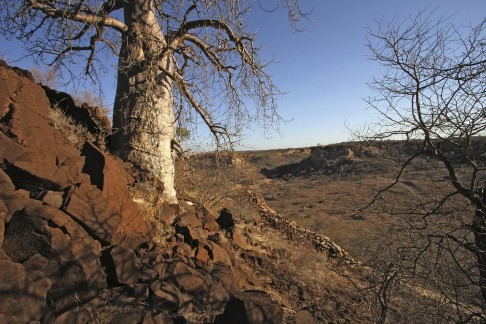South Africa's golden rhino may make overseas debut
Prospect of golden rhinoceros of Mapungubwe, potent symbol of precolonial civilisation, going on show in Britain hasn't been universally welcomed

The golden rhinoceros of Mapungubwe, the defining symbol of precolonial civilisation in South Africa, could leave the country for the first time next year on loan to the British Museum for an unprecedented exhibition of South African art.
It has been described as southern Africa's equivalent of Tutankhamen's mask or the Staffordshire Hoard, but the small foil figure could also become a political football as the South African government weighs the request in what some fear will be a decision motivated by anti-Western grandstanding. It rejected a proposal for the rhino to be displayed in Paris in 2001.
Mapungubwe, in the far north of South Africa bordering present-day Botswana and Zimbabwe, was the biggest kingdom on the subcontinent by the 13th century. It had a sophisticated state and economic system that included agriculture, mining and advanced artisanship, and traded gold and ivory with Asia and Egypt. The site was rediscovered in 1933 and excavated by the University of Pretoria, yielding a vast quantity of gold jewellery including anklets, bracelets, necklaces, beads and animal figurines recovered from three elite burials.
But for decades it was largely ignored in South Africa because it contradicted the racist ideology of apartheid, which taught that history began when the first Dutch settler arrived in Cape Town in 1652. Few were willing to contemplate that the rhino, made of several pieces of thin gold foil originally nailed on to a wooden carving, could be the work of a much earlier black culture.
"A civilisation like this existed nearly a thousand years ago," says Theo van Wyk, head of the arts department at the University of Pretoria. "The conventional view is that it was dark Africa, but it was a trading point for many."
Since the coming of multiracial democracy, Mapungubwe has been declared a World Heritage Site by Unesco and incorporated into a national park. A museum on the university campus holds 9kg of gold treasures found at the site - the biggest archaeological collection of gold artefacts in sub-Saharan Africa - of which 3.5kg, including the rhino, are on display.
Sian Tiley-Nel, museum manager and chief curator of the Mapungubwe collection, says: "You can compare it with the great Staffordshire Hoard. It's not as ornate as your Anglo-Saxon gold, but it's just as impressive and just as beautiful. But for centuries, these artefacts were neglected."

The British Museum intends to request loans of the rhino along with a golden sceptre and golden bowl, all of which its experts helped reconstruct more than a decade ago, Tiley-Nel adds. The bowl was transported to London for a year for the purpose, becoming the only gold object from Mapungubwe to leave the country so far.
The formal request has not yet been received by the university, she says, and will depend on export permit approvals. "The government might say sorry. In 2001 we had a request for the golden rhino to go to Paris. The university had agreed but it was just after September 11 and the government said no for terrorism reasons. It was so ridiculous. It would have been the centrepiece of the exhibition. The world needs to see this rhino. The world needs to see this collection."
South Africa's governing ANC might argue that the golden rhino is such a precious crown jewel that it ranks alongside Tutankhamen's mask or the Mona Lisa as off-limits to foreign museums in recent years. It could also point to the long and painful history of African treasures being looted by colonisers for display in European museums, and to all those seeking restitution. Such is Mapungubwe's importance in the post-apartheid national narrative that South Africa's highest honour is the Order of Mapungubwe, of which Nelson Mandela was the first recipient.
Van Wyk adds: "There are ideological connotations. Some if it might be politically driven."
The British Museum confirmed it has scheduled a proposed South African art exhibition from October 2016 to February 2017. Kate Morais, a spokeswoman, says: "This exhibition will explore South African art from the world's oldest art object, three million years ago, to the contemporary art of today. In so doing, the exhibition will tell an object-based history of South Africa.
"The exhibition will draw on the British Museum's extensive South African collection, which will be exhibited alongside key archaeological, historic and contemporary loans from South Africa. It is too early for us to discuss what these loans from South Africa might be."
Nathi Mthethwa, South Africa's arts and culture minister, says: "There have been discussions. I don't have a response as to whether the government will accede to the loan." Asked if the government is likely to say yes, Mthethwa adds: "You're putting me in a corner. Let me not answer."
Meanwhile, the University of Pretoria plans to move the rhino and other key artefacts to a new, more publicly accessible museum on its campus next year, despite calls to return the rhino to its original Iron Age site. In 2007, ancient human remains that had been excavated were finally sent back to local people for reburial on top of Mapungubwe Hill.
Tiley-Nel casts the debate as "Elginism" - a reference to the British Museum's tug-of-war with Greece over the Parthenon marbles - and says the university museums have received 20,000 visitors so far this year, whereas Mapungubwe is a six-hour drive from Johannesburg.
"We've loaned a large part of the collection to the interpretive centre, but it's in the middle of nowhere and security is a main concern. It's not a functioning museum. It would be like taking the golden rhino and displaying it on top of Table Mountain. We need to be responsible for its security because it's completely priceless."
The Guardian